The photovoltaic silane coupling agent market is forecast to expand from USD 1.4 billion in 2025 to USD 2.5 billion by 2035, rising at a CAGR of 5.8% and adding USD 1.1 billion in absolute value over the decade. The industry is evolving with high-performance epoxy-based coupling systems gaining widespread usage across EVA and POE film production, driving bonding efficiency and long-term durability in photovoltaic modules. Growth is influenced by rising solar capacity additions, government-backed renewable energy projects, and the standardization of encapsulation technologies that demand precision adhesion solutions.
The first half of the period, from 2025 to 2030, will contribute USD 0.4 billion, reflecting 33% of total growth, while the latter half, from 2030 to 2035, will account for USD 0.7 billion, or 67%, led by large-scale solar module expansion and advanced silane integration across Asia Pacific and Europe. China, expanding at a 7.8% CAGR, leads global growth through massive solar module production capacity, large-scale photovoltaic parks, and government initiatives supporting local chemical production.
High-volume EVA and POE film manufacturers in Jiangsu, Zhejiang, and Anhui have accelerated the adoption of epoxy group silane coupling agents to enhance film adhesion and minimize lamination defects. India, growing at a 7.3% CAGR, is closely followed by rising photovoltaic manufacturing activity in Gujarat and Maharashtra, where solar module producers integrate silane coupling agents to improve efficiency in local assembly lines under the National Solar Mission.
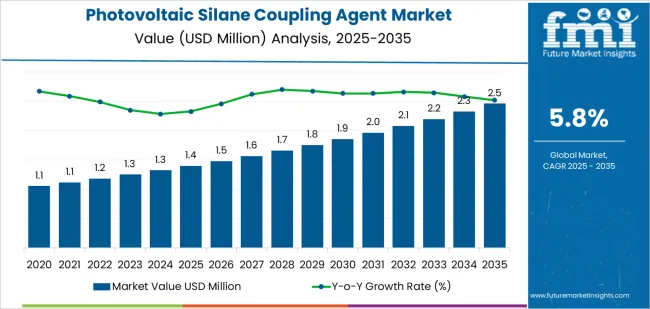
Germany, advancing at a 6.7% CAGR, remains Europe’s technology hub, benefiting from advanced solar module R&D, Industry 4.0 integration, and strict EU performance standards promoting high-quality silane formulations. Brazil, recording a 6.1% CAGR, strengthens its position through solar farm development and chemical industry investments, enabling regional supply. The United States, with a 5.5% CAGR, continues to integrate silane agents in large-scale PV module assembly lines, particularly in California and Arizona, where manufacturers prioritize performance reliability and adhesion optimization.
Mature markets such as the United Kingdom (4.9%) and Japan (4.4%) display consistent adoption driven by regulatory compliance, process precision, and emphasis on long-term bonding reliability in high-efficiency solar panels. Japanese producers in Osaka and Kyushu increasingly favor epoxy group formulations for advanced lamination and quality consistency. Across these seven major economies, Asia Pacific dominates with China and India together contributing over 45% of total incremental global value, while Europe sustains growth momentum through precision formulation and standardized manufacturing compliance.
Photovoltaic Silane Coupling Agent Market Year-over-Year Forecast (2025-2035)
The latter half (2030-2035) will witness sustained growth from USD 1.8 billion to USD 2.5 billion, representing an addition of USD 0.7 billion or 67% of the decade's expansion. This period will be defined by mass market penetration of specialized silane coupling agent formulations, integration with comprehensive solar manufacturing platforms, and seamless compatibility with existing photovoltaic production infrastructure. The market trajectory signals fundamental shifts in how manufacturers approach film adhesion optimization and production quality management, with participants positioned to benefit from sustained demand across multiple functional group types and application segments.
The photovoltaic silane coupling agent market demonstrates distinct growth phases with varying market characteristics and competitive dynamics. Between 2025 and 2030, the market progresses through its technology adoption phase, expanding from USD 1.4 billion to USD 1.8 billion with steady annual increments averaging 5.8% growth. This period showcases the transition from basic silane formulations to advanced epoxy group systems with enhanced adhesion capabilities and integrated quality control systems becoming mainstream features.
The 2025-2030 phase adds USD 365.1 million to market value, representing 33% of total decade expansion. Market maturation factors include standardization of photovoltaic manufacturing and solar film protocols, declining component costs for specialized silane formulations, and increasing industry awareness of coupling agent benefits reaching optimal adhesion effectiveness in EVA and POE film applications. Competitive landscape evolution during this period features established chemical manufacturers like Momentive and Dow expanding their silane portfolios while specialty manufacturers focus on advanced formulation development and enhanced performance capabilities.
From 2030 to 2035, market dynamics shift toward advanced functional group integration and global manufacturing expansion, with growth continuing from USD 1.8 billion to USD 2.5 billion, adding USD 727.9 million or 67% of total expansion. This phase transition centers on specialized silane formulation systems, integration with automated production networks, and deployment across diverse photovoltaic manufacturing scenarios, becoming standard rather than specialized applications. The competitive environment matures with focus shifting from basic coupling capability to comprehensive film adhesion optimization systems and integration with production monitoring platforms.
| Metric | Value |
|---|---|
| Market Value (2025) | USD 1.4 billion |
| Market Forecast (2035) | USD 2.5 billion |
| Growth Rate | 5.8% CAGR |
| Leading Technology | Epoxy Group Functional Type |
| Primary Application | EVA Film Application Segment |
The market demonstrates strong fundamentals with epoxy group systems capturing a dominant share through advanced adhesion promotion and film bonding optimization capabilities. EVA film applications drive primary demand, supported by increasing photovoltaic module production and enhanced film adhesion technology requirements. Geographic expansion remains concentrated in developed markets with established solar manufacturing infrastructure, while emerging economies show accelerating adoption rates driven by renewable energy expansion and rising solar production standards.
Market expansion rests on three fundamental shifts driving adoption across the EVA film, POE film, and photovoltaic manufacturing sectors. First, solar module production demand creates compelling operational advantages through silane coupling agents that provide immediate adhesion enhancement and film bonding without compromising production efficiency, enabling manufacturers to meet stringent performance standards while maintaining manufacturing productivity and reducing material waste. Second, photovoltaic technology modernization accelerates as solar manufacturers worldwide seek advanced silane systems that complement traditional film processes, enabling precise adhesion control and quality management that align with industry standards and performance regulations.
Third, renewable energy expansion drives adoption from solar module producers and film manufacturers requiring effective coupling solutions that maximize bonding strength while maintaining operational productivity during lamination and encapsulation operations. Growth faces headwinds from raw material cost challenges that vary across chemical suppliers regarding the sourcing of silane compounds and specialty functional groups, which may limit adoption in cost-sensitive environments. Technical limitations also persist regarding formulation compatibility and processing concerns that may reduce effectiveness in certain film compositions and manufacturing scenarios, which affect adhesion performance and production requirements.
The photovoltaic silane coupling agent market represents a specialized yet critical material opportunity driven by expanding global solar module production, photovoltaic manufacturing modernization, and the need for superior film adhesion in diverse renewable energy applications. As manufacturers worldwide seek to achieve optimal bonding effectiveness, reduce production defects, and integrate advanced coupling systems with automated platforms, photovoltaic silane coupling agents are evolving from basic adhesion promoters to sophisticated bonding solutions ensuring film quality and production leadership.
The market's growth trajectory from USD 1443.3 million in 2025 to USD 2536.3 million by 2035 at a 5.8% CAGR reflects fundamental shifts in solar manufacturing adhesion requirements and photovoltaic film optimization. Geographic expansion opportunities are particularly pronounced in Asia Pacific markets, while the dominance of epoxy group systems and EVA film applications provides clear strategic focus areas.
Strengthening the dominant epoxy group segment through enhanced functional formulations, superior adhesion performance, and automated application systems. This pathway focuses on optimizing silane composition, improving bonding effectiveness, extending operational performance to optimal adhesion rates, and developing specialized formulations for diverse applications. Market leadership consolidation through advanced chemical engineering and automated production integration enables premium positioning while defending competitive advantages against alternative coupling agents. Expected revenue pool: USD 140-180 million
Rapid photovoltaic module and solar manufacturing growth across Asia Pacific creates substantial expansion opportunities through local production capabilities and technology transfer partnerships. Growing solar panel production and government renewable energy initiatives drive sustained demand for advanced silane coupling systems. Localization strategies reduce import costs, enable faster technical support, and position companies advantageously for procurement programs while accessing growing domestic markets. Expected revenue pool: USD 115-155 million
Expansion within the dominant EVA film segment through specialized silane formulations addressing photovoltaic module standards and high-volume production requirements. This pathway encompasses automated application systems, quality control integration, and compatibility with diverse film manufacturing processes. Premium positioning reflects superior adhesion performance and comprehensive production compliance supporting modern EVA film manufacturing. Expected revenue pool: USD 95-130 million
Strategic expansion into POE film applications requires enhanced formulation capabilities and specialized silane compositions addressing advanced film operational requirements. This pathway addresses premium adhesion performance, durability enhancement, and specialized bonding with advanced chemical engineering for demanding photovoltaic standards. Premium pricing reflects specialized formulation requirements and extended performance standards. Expected revenue pool: USD 80-110 million
Expansion of methacryloyloxy group segment through enhanced chemical reactivity, specialized bonding properties, and advanced photovoltaic application requirements. This pathway encompasses high-performance film applications, advanced solar modules, and specialty formulations requiring superior coupling agent characteristics. Market development through advanced silane engineering enables differentiated positioning while accessing premium markets requiring specialized functional group solutions. Expected revenue pool: USD 65-90 million
Development of amino group and other specialized silane formulations addressing specific photovoltaic requirements and niche bonding demands. This pathway encompasses hybrid formulations, application-optimized materials, and cost-effective alternatives for emerging solar segments. Technology differentiation through proprietary compositions enables diversified revenue streams while reducing dependency on single functional group platforms. Expected revenue pool: USD 55-75 million
Development of comprehensive technical support services addressing formulation optimization and application requirements across EVA and POE film manufacturing. This pathway encompasses application testing, production optimization, and performance documentation. Premium positioning reflects technical expertise and application knowledge while enabling access to quality-focused procurement programs and performance-driven manufacturer partnerships. Expected revenue pool: USD 45-65 million
Primary Classification: The market segments by functional group into Epoxy Group, Methacryloyloxy Group, Amino Group, and Others categories, representing the evolution from basic coupling agents to specialized silane solutions for comprehensive photovoltaic film optimization.
Secondary Classification: Application segmentation divides the market into EVA Film, POE Film, and other application sectors, reflecting distinct requirements for adhesion performance, bonding capacity, and film manufacturing standards.
Regional Classification: Geographic distribution covers Asia Pacific, Europe, North America, and other regions, with developed markets leading adoption while emerging economies show accelerating growth patterns driven by renewable energy expansion programs.
The segmentation structure reveals technology progression from standard silane-based formulations toward specialized functional group systems with enhanced adhesion and bonding capabilities, while application diversity spans from EVA film manufacturing to specialized POE and photovoltaic applications requiring precise coupling solutions.
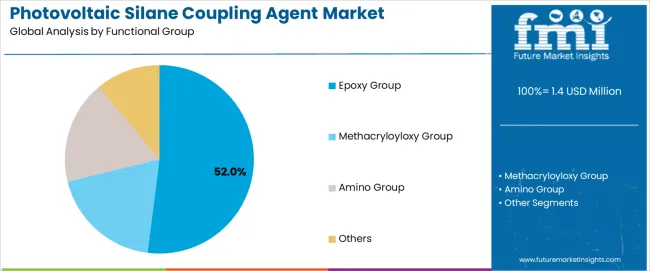
Market Position: Epoxy group systems command the leading position in the Photovoltaic Silane Coupling Agent market with approximately 52% market share through advanced chemical properties, including superior adhesion performance, optimal bonding capability, and production optimization that enable manufacturers to achieve effective film coupling across diverse photovoltaic manufacturing environments.
Value Drivers: The segment benefits from manufacturer preference for reliable silane systems that provide consistent adhesion performance, reduced bonding failures, and film quality enhancement without requiring significant process modifications. Advanced formulation features enable automated application systems, adhesion consistency, and integration with existing photovoltaic equipment, where coupling agent performance and production reliability represent critical operational requirements.
Competitive Advantages: Epoxy group systems differentiate through proven chemical reactivity, consistent bonding characteristics, and integration with automated manufacturing systems that enhance operational effectiveness while maintaining optimal adhesion suitable for diverse solar film applications.
Key market characteristics:
Methacryloyloxy group systems maintain specialized functional positioning in the Photovoltaic Silane Coupling Agent market due to their advanced chemical properties and specialized application advantages. These systems appeal to manufacturers requiring enhanced coupling agents with superior performance for advanced photovoltaic film applications. Market adoption is driven by high-performance solar module expansion, emphasizing specialized bonding solutions and operational effectiveness through optimized silane formulation systems while maintaining competitive performance structures.
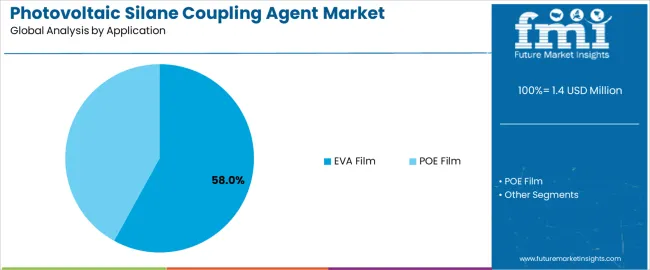
Market Context: EVA film applications dominate the Photovoltaic Silane Coupling Agent market with approximately 58% market share due to widespread adoption of silane coupling technology and increasing focus on film adhesion, bonding performance, and manufacturing quality applications that minimize production failures while maintaining photovoltaic industry standards.
Appeal Factors: EVA film manufacturers prioritize adhesion reliability, bonding consistency, and integration with existing photovoltaic production infrastructure that enables coordinated coupling agent application across multiple module lines. The segment benefits from substantial solar manufacturing investment and production programs that emphasize the acquisition of silane coupling agents for quality control and adhesion optimization applications.
Growth Drivers: Photovoltaic module expansion programs incorporate silane coupling agents as standard materials for solar film operations, while renewable energy industry growth increases demand for enhanced adhesion capabilities that comply with performance standards and minimize production defects.
Market Challenges: Varying photovoltaic manufacturing standards and film composition differences may limit formulation standardization across different production facilities or operational scenarios.
Application dynamics include:
POE film applications capture significant market share through specialized adhesion requirements in advanced photovoltaic manufacturing, high-performance solar module production, and premium film bonding applications. These facilities demand robust silane systems capable of providing superior adhesion while ensuring exceptional bonding performance and specialized coupling capabilities.
Growth Accelerators: Photovoltaic manufacturing expansion drives primary adoption as silane coupling agents provide superior adhesion capabilities that enable solar manufacturers to meet stringent performance standards without excessive material costs, supporting production operations and renewable energy missions that require precise film bonding applications. Solar module production demand accelerates market expansion as manufacturers seek effective coupling systems that optimize adhesion performance while maintaining operational effectiveness during lamination and encapsulation scenarios. Renewable energy investment increases worldwide, creating sustained demand for advanced adhesion systems that complement traditional film processes and provide bonding optimization in competitive markets.
Growth Inhibitors: Raw material cost challenges vary across chemical suppliers regarding the sourcing of silane compounds and specialty functional groups, which may limit operational flexibility and market penetration in regions with volatile commodity prices or cost-sensitive photovoltaic operations. Technical performance limitations persist regarding formulation compatibility and processing concerns that may reduce effectiveness in certain film compositions, manufacturing conditions, or application scenarios, affecting adhesion durability and production requirements. Market fragmentation across multiple photovoltaic manufacturing standards and film formulations creates compatibility concerns between different silane suppliers and existing production infrastructure.
Market Evolution Patterns: Adoption accelerates in high-efficiency solar modules and advanced photovoltaic sectors where adhesion performance justifies coupling agent costs, with geographic concentration in developed markets transitioning toward mainstream adoption in emerging economies driven by renewable energy expansion and manufacturing capacity awareness. Technology development focuses on enhanced silane formulations, improved application integration, and compatibility with automated lamination systems that optimize film bonding and adhesion effectiveness. The market could face disruption if alternative adhesion technologies or bonding innovations significantly limit the deployment of silane-based coupling agents in photovoltaic applications, though silane material's unique combination of chemical reactivity, adhesion performance, and film bonding continues to make it preferred in solar manufacturing applications.
The Photovoltaic Silane Coupling Agent market demonstrates varied regional dynamics with Growth Leaders including China (7.8% CAGR) and India (7.3% CAGR) driving expansion through solar manufacturing capacity additions and renewable energy programs. Steady Performers encompass Germany (6.7% CAGR), Brazil (6.1% CAGR), and United States (5.5% CAGR), benefiting from established photovoltaic industries and advanced solar technology adoption. Mature Markets feature United Kingdom (4.9% CAGR) and Japan (4.4% CAGR), where specialized solar manufacturing applications and advanced film integration support consistent growth patterns.
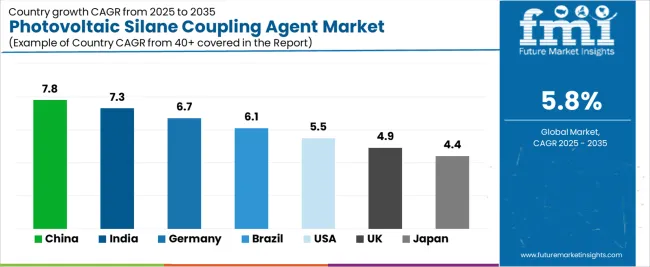
| Country | CAGR (2025-2035) |
|---|---|
| China | 7.8% |
| India | 7.3% |
| Germany | 6.7% |
| Brazil | 6.1% |
| United States | 5.5% |
| United Kingdom | 4.9% |
| Japan | 4.4% |
Regional synthesis reveals Asia Pacific markets leading adoption through solar manufacturing expansion and photovoltaic production infrastructure development, while European countries maintain steady expansion supported by renewable energy technology advancement and environmental standardization requirements. North American markets show moderate growth driven by solar panel production applications and sustainable energy integration trends.

The Chinese market emphasizes advanced coupling features, including precision adhesion control and integration with comprehensive solar manufacturing platforms that manage production quality, bonding optimization, and film performance applications through unified monitoring systems. The country demonstrates strong growth at 7.8% CAGR, driven by photovoltaic manufacturing expansion, renewable energy initiatives, and emerging solar technology development that support silane coupling agent integration. Chinese solar manufacturers prioritize operational effectiveness with silane coupling agents delivering consistent film bonding through advanced formulation capabilities and production adaptation features.
Technology deployment channels include major photovoltaic manufacturers, specialized chemical suppliers, and solar industry procurement programs that support professional applications for complex EVA film bonding and POE film adhesion applications. Manufacturing platform integration capabilities with established solar systems expand market appeal across diverse operational requirements seeking enhanced adhesion and production benefits. The expanding renewable energy sector and accelerating solar manufacturing capacity create sustained demand, while innovative applications in high-efficiency modules and advanced photovoltaics open new growth avenues.
Performance Metrics:
Advanced solar manufacturing market in Germany demonstrates sophisticated coupling agent deployment with documented operational effectiveness in photovoltaic film bonding applications and solar module facilities through integration with existing production systems and manufacturing infrastructure. The country leverages engineering expertise in renewable energy technology and manufacturing systems integration to maintain strong growth at 6.7% CAGR. Industrial centers, including Bavaria, Baden-Württemberg, and Lower Saxony, showcase advanced installations where coupling agent systems integrate with comprehensive solar platforms and production management systems to optimize photovoltaic manufacturing and adhesion effectiveness.
German solar manufacturers prioritize system performance and EU compliance in formulation development, creating demand for premium coupling systems with advanced features, including automated application and quality control systems. The market benefits from established renewable energy infrastructure and a willingness to invest in advanced adhesion technologies that provide long-term production benefits and compliance with international environmental and quality standards.
Market Intelligence Brief:
The USA photovoltaic coupling agent market demonstrates sophisticated deployment across solar manufacturing applications with documented effectiveness in module production and film bonding facilities through integration with comprehensive production management systems and quality control infrastructure. The country leverages advanced manufacturing capabilities in solar technology and adhesion optimization technologies to maintain moderate growth at 5.5% CAGR. Industrial centers, including California, Arizona, and Texas, showcase advanced installations where coupling agent systems integrate with comprehensive photovoltaic platforms and production networks to optimize manufacturing and adhesion effectiveness.
American solar manufacturers prioritize production efficiency and performance optimization in formulation development, creating demand for innovative coupling systems with advanced features, including smart manufacturing integration and automated application systems. The market benefits from established renewable energy infrastructure and willingness to invest in advanced adhesion technologies that provide long-term manufacturing benefits and compliance with federal and environmental standards.
Market Intelligence Brief:
The UK photovoltaic coupling agent market demonstrates advanced renewable energy deployment with documented operational effectiveness in solar manufacturing applications and module production facilities through integration with existing environmental compliance systems and production infrastructure. The country leverages regulatory expertise in sustainable energy and manufacturing systems integration to maintain steady growth at 4.9% CAGR. Industrial centers, including South East England, Scotland, and Wales, showcase advanced installations where coupling agent systems integrate with comprehensive sustainability platforms and production management systems to optimize environmental compliance and adhesion effectiveness.
British solar manufacturers prioritize system sustainability and regulatory compliance in formulation development, creating demand for certified coupling systems with advanced features, including carbon footprint tracking and renewable energy integration. The market benefits from established solar manufacturing infrastructure and commitment to invest in sustainable adhesion technologies that provide long-term environmental benefits and compliance with UK and EU environmental standards.
Strategic Market Indicators:
Photovoltaic coupling agent market in India demonstrates rapid expansion deployment with documented operational effectiveness in solar manufacturing applications and module production facilities through integration with emerging production systems and renewable energy infrastructure. The country leverages growing industrial capabilities in solar technology and manufacturing systems integration to achieve high growth at 7.3% CAGR. Industrial centers, including Gujarat, Maharashtra, and Rajasthan, showcase expanding installations where coupling agent systems integrate with comprehensive solar platforms and distribution networks to optimize market penetration and adhesion effectiveness.
Indian solar manufacturers prioritize production capacity and performance standards in formulation development, creating demand for effective coupling systems with advanced features, including automated application integration and quality control systems. The market benefits from expanding renewable energy infrastructure and willingness to invest in international-standard adhesion technologies that provide manufacturing optimization and compliance with global quality standards.
Market Intelligence Brief:
Photovoltaic coupling agent market in Japan demonstrates precision deployment with documented operational effectiveness in advanced solar manufacturing applications and high-efficiency module facilities through integration with sophisticated production systems and quality control infrastructure. The country leverages engineering excellence in precision manufacturing and production systems integration to maintain steady growth at 4.4% CAGR. Industrial centers, including Tokyo, Osaka, and Kyushu, showcase advanced installations where coupling agent systems integrate with comprehensive quality platforms and production optimization systems to achieve manufacturing excellence and adhesion effectiveness.
Japanese solar manufacturers prioritize system precision and performance excellence in formulation development, creating demand for advanced coupling systems with sophisticated features, including micro-precision application and quality integration systems. The market benefits from established solar technology infrastructure and commitment to invest in highest-quality adhesion technologies that provide superior production positioning and compliance with stringent Japanese quality standards.
Strategic Market Indicators:

The Photovoltaic Silane Coupling Agent market in Europe is projected to grow substantially over the forecast period, with Germany expected to maintain its leadership position with a significant market share supported by its advanced solar manufacturing infrastructure and major photovoltaic production centers in Bavaria and Baden-Württemberg. France follows with strong market presence, driven by comprehensive renewable energy programs and solar technology initiatives. The United Kingdom holds substantial market share through specialized photovoltaic manufacturing activities, sustainable energy applications, and solar module production. Italy commands notable market presence through strong solar panel manufacturing and renewable energy projects. Spain accounts for growing market share aided by photovoltaic capacity expansion and solar energy adoption. The Netherlands maintains steady share driven by specialty solar applications and sustainable manufacturing demand. The Rest of Europe region is anticipated to show steady adoption, reflecting consistent growth in Nordic countries, renewable energy expansion in Central European markets, and solar manufacturing upgrades across Eastern European production facilities.
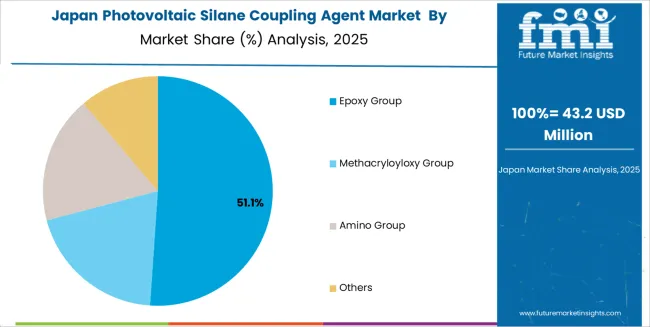
In Japan, the Photovoltaic Silane Coupling Agent market prioritizes epoxy group systems, which capture the dominant share of high-efficiency solar module and advanced photovoltaic installations due to their advanced features, including precision adhesion optimization and seamless integration with existing solar manufacturing infrastructure. Japanese photovoltaic manufacturers emphasize reliability, precision, and long-term bonding excellence, creating demand for epoxy group systems that provide consistent coupling capabilities and superior chemical performance based on manufacturing requirements and quality standards. Methacryloyloxy group maintains secondary positions primarily in specialized photovoltaic applications and advanced solar module installations where comprehensive bonding functionality meets operational requirements without compromising production efficiency.
Market Characteristics:

In South Korea, the market structure favors international chemical manufacturers, including Momentive, Dow, and Wacker, which maintain dominant positions through comprehensive product portfolios and established photovoltaic industry networks supporting both solar module manufacturing and film production installations. These providers offer integrated solutions combining advanced coupling agent systems with professional technical services and ongoing application support that appeal to Korean solar manufacturers seeking reliable adhesion systems. Local chemical contractors and formulation specialists capture moderate market share by providing localized service capabilities and competitive pricing for standard photovoltaic applications, while domestic manufacturers focus on specialized formulations and cost-effective solutions tailored to Korean solar manufacturing characteristics.
Channel Insights:
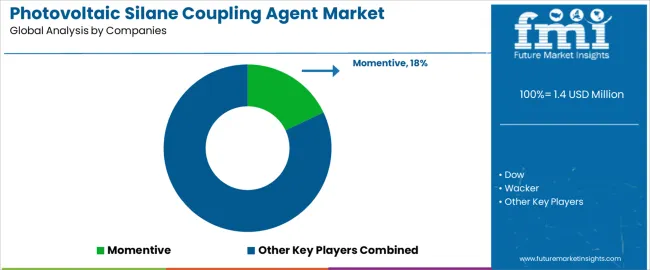
The photovoltaic silane coupling agent market operates with moderate concentration, featuring approximately 15-18 meaningful participants, where leading companies control roughly 50-55% of the global market share through established solar manufacturing relationships and comprehensive silane coupling portfolios. Competition emphasizes advanced formulation capabilities, adhesion performance, and photovoltaic manufacturer integration rather than price-based rivalry. The leading companies maintain competitive positions through extensive chemical expertise and global solar industry presence.
Market Leaders encompass Momentive, Dow, Wacker, and Evonik, which maintain competitive advantages through extensive silane technology expertise, global photovoltaic manufacturer networks, and comprehensive formulation integration capabilities that create customer loyalty and support premium pricing. These companies leverage decades of chemical technology experience and ongoing innovation investments to develop advanced coupling agent systems with precision adhesion control and performance features. Technology Innovators include JNC, PCC Group, and regional specialists, which compete through specialized silane formulation technology focus and innovative bonding capabilities that appeal to solar manufacturers seeking advanced adhesion solutions and production optimization. These companies differentiate through rapid formulation development cycles and specialized photovoltaic application focus.
Regional Specialists feature chemical manufacturers focusing on specific geographic markets and specialized applications, including sustainable coupling systems and integrated solar manufacturing solutions. Market dynamics favor participants that combine reliable silane formulations with advanced adhesion capabilities, including precision bonding control and automatic performance optimization features. Competitive pressure intensifies as traditional chemical suppliers expand into photovoltaic coupling systems, while specialized solar material companies challenge established players through innovative formulation solutions and advanced platforms targeting EVA film and POE film segments.
| Item | Value |
|---|---|
| Quantitative Units | USD 1.4 billion |
| Functional Group | Epoxy Group, Methacryloyloxy Group, Amino Group, Others |
| Application | EVA Film, POE Film |
| Regions Covered | Asia Pacific, Europe, North America, Latin America, Middle East & Africa |
| Countries Covered | China, India, Germany, Brazil, United States, United Kingdom, Japan, and 20+ additional countries |
| Key Companies Profiled | Momentive, Dow, Wacker, Evonik, JNC, PCC Group, Nagase, Shin Etsu, Chengdu Guibao Science and Technology, Jiangxi Chen Guang New Materials, HUBEI BLUESKY NEW MATERIAL INC., Hengda Silane, Jiangxi Hungpai New Material, Nanjing Capaue Chemical |
| Additional Attributes | Dollar sales by functional group and application categories, regional adoption trends across Asia Pacific, Europe, and North America, competitive landscape with chemical manufacturers and solar material suppliers, manufacturer preferences for adhesion performance and production efficiency, integration with photovoltaic manufacturing platforms and film quality monitoring systems, innovations in specialized silane formulations and bonding excellence, and development of automated application solutions with enhanced performance and manufacturing optimization capabilities. |
The global photovoltaic silane coupling agent market is estimated to be valued at USD 1.4 million in 2025.
The market size for the photovoltaic silane coupling agent market is projected to reach USD 2.5 million by 2035.
The photovoltaic silane coupling agent market is expected to grow at a 5.8% CAGR between 2025 and 2035.
The key product types in photovoltaic silane coupling agent market are epoxy group , methacryloyloxy group, amino group and others.
In terms of application, eva film segment to command 58.0% share in the photovoltaic silane coupling agent market in 2025.






Full Research Suite comprises of:
Market outlook & trends analysis
Interviews & case studies
Strategic recommendations
Vendor profiles & capabilities analysis
5-year forecasts
8 regions and 60+ country-level data splits
Market segment data splits
12 months of continuous data updates
DELIVERED AS:
PDF EXCEL ONLINE
Photovoltaic Grade High Purity Crystalline Silicon Market Size and Share Forecast Outlook 2025 to 2035
Photovoltaic Mounting System Market Analysis - Size, Share, and Forecast 2025 to 2035
UK Photovoltaic Mounting System Market Growth - Trends & Forecast 2025 to 2035
Solar Photovoltaic (PV) Market Size and Share Forecast Outlook 2025 to 2035
Solar Photovoltaic Wafer Market
Europe Photovoltaic Mounting System Market – Trends & Forecast 2025 to 2035
On-Site Solar Power Market Growth – Trends & Forecast 2025 to 2035
Thin Film Photovoltaics Market Size and Share Forecast Outlook 2025 to 2035
Thin Film Photovoltaic Modules Market
High Concentration Photovoltaics Market Analysis by Type of Power Generation, Application, and Region Through 2035
Special Sealant for Photovoltaic Modules Market Forecast and Outlook 2025 to 2035
Building Integrated Photovoltaics Market - Solar & Architecture
Silicone Sealants for Photovoltaic Assembly Market Forecast and Outlook 2025 to 2035
Semiconductors in Solar PV Power Systems Market Growth - Trends & Forecast 2025 to 2035
Silanes Market Growth - Trends & Forecast 2025 to 2035
Silane Coupling Agents Market Size and Share Forecast Outlook 2025 to 2035
Chlorosilane Market Size and Share Forecast Outlook 2025 to 2035
Market Share Insights of Leading Trichlorosilane Providers
Tetraethoxysilane Market Size and Share Forecast Outlook 2025 to 2035
Dimethyldichlorosilane Market Size and Share Forecast Outlook 2025 to 2035

Thank you!
You will receive an email from our Business Development Manager. Please be sure to check your SPAM/JUNK folder too.
Chat With
MaRIA